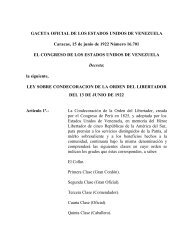Chapter 4
Chapter 4
Chapter 4
You also want an ePaper? Increase the reach of your titles
YUMPU automatically turns print PDFs into web optimized ePapers that Google loves.
Figure 4.3.3 Gaussian “pillbox” for computing the electric<br />
field outside the conductor.<br />
To<br />
compute the field strength just outside the conductor, consider the Gaussian pillbox<br />
drawn in Figure 4.3.3. Using Gauss’s law, we obtain<br />
or<br />
A<br />
E d EnA (0) A σ<br />
Φ = ∫∫ E⋅ A=<br />
+ ⋅ =<br />
ε<br />
<br />
(4.3.2)<br />
S<br />
En<br />
0<br />
0<br />
σ<br />
= (4.3.3)<br />
ε<br />
The above result holds for a conductor of arbitrary shape. The pattern of the electric field<br />
line directions for the region near a conductor is shown in Figure 4.3.4.<br />
Figure 4.3.4 Just outside the conductor, E is always perpendicular to the surface.<br />
As in the examples of an infinitely large non-conducting plane and a spherical shell, the<br />
normal component of the electric field exhibits a discontinuity<br />
at the boundary:<br />
( + ) ( −)<br />
σ σ<br />
∆ En = En − En<br />
= − 0 =<br />
ε ε<br />
0 0<br />
Example 4.5: Conductor with Charge Inside a Cavity<br />
17

















